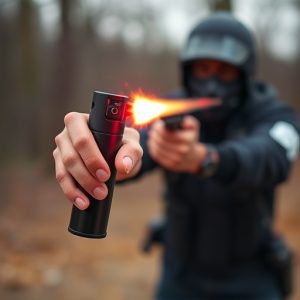Capsaicin Crowd Control: Effectiveness, Safety, and Removal Techniques
Capsaicin, the heat-inducing compound in chili peppers, is used in crowd control sprays for its abil…….
Capsaicin, the heat-inducing compound in chili peppers, is used in crowd control sprays for its ability to irritate sensory systems. These non-lethal products are a game-changer for managing large gatherings, but prompt removal of pepper spray from clothing and skin is crucial after exposure due to its potential irritant properties. Effective decontamination involves quickly taking off contaminated garments, soaking in cold water, using neutralizing solutions like baking soda or vinegar, gently rubbing the paste on fabric, and thoroughly washing with soap and water. Strict regulations, safe handling practices, and regular maintenance are essential for their effective and safe use, while ongoing research aims to improve formulations and decontamination methods to address environmental challenges and ensure better removal of pepper spray from clothing.
“Discover the power of capsicum-based inflammatory crowd control sprays, a non-lethal solution transforming public safety. Learn how this active ingredient, famously known for its heat, effectively disperses crowds while exploring its mechanism and impact. Delve into practical aspects like removal techniques—understanding how to quickly and safely cleanse pepper spray from clothing. Balance innovation with caution by examining legal considerations and real-world applications, including success stories and challenges faced in implementing these cutting-edge tools.”
- Understanding Capsaicin: The Active Ingredient
- How Capsaicin-Based Sprays Work for Crowd Control
- Effective Removal Techniques: Getting Pepper Spray Off Clothing
- Legal and Safety Considerations for Crowd Control Sprays
- Real-World Applications: Success Stories and Challenges
Understanding Capsaicin: The Active Ingredient
Capsaicin, the active ingredient in pepper spray, is a natural compound derived from chili peppers. It’s what gives spicy foods their heat and pungent aroma. In the context of crowd control, capsaicin creates an intense irritation to the eyes, nose, and respiratory system, temporarily disabling individuals and dispersing crowds safely. When exposed to skin or inhaled, capsaicin binds to specific nerve endings, triggering a response that leads to tears, coughing, and difficulty breathing.
Understanding how capsaicin works is crucial in effective crowd control strategies. Proper use involves ensuring the spray reaches its target area, often face and upper body, for optimal effectiveness. Additionally, knowing how to remove pepper spray from clothing is essential for post-incident care and decontamination. Simple measures like using water and mild soap can help flush out capsaicin residue, but specialized cleaning products designed for pepper spray removal are recommended for deeper cleaning and to prevent skin irritation.
How Capsaicin-Based Sprays Work for Crowd Control
Capsaicin-based crowd control sprays have gained attention for their unique ability to disperse and manage large gatherings. These innovative products work by utilizing capsaicin, a natural compound found in chili peppers. When sprayed, it activates sensory receptors in the skin and eyes, triggering an intense burning sensation. This immediate reaction causes individuals to experience discomfort, prompting them to quickly leave the area.
The effectiveness of these sprays lies in their non-lethal nature, making them a preferred choice for law enforcement and crowd management professionals. Unlike traditional pepper spray, which can adhere to clothing and cause prolonged irritation, capsaicin-based sprays are designed to break down rapidly, allowing for easier removal from clothing and skin. This feature ensures that bystanders and individuals with sensitive skin are not harmed or left with unpleasant residues.
Effective Removal Techniques: Getting Pepper Spray Off Clothing
When faced with pepper spray, removing it from clothing promptly is crucial for both comfort and safety. The first step is to quickly remove any contaminated garments, taking care not to rub or wipe, as this can spread the irritant further. Soaking the affected area in cold water for at least 15 minutes helps to dilute and flush out the capsaicin, the active ingredient in pepper spray.
For stubborn stains, applying a neutralizing solution like baking soda paste or a mixture of vinegar and water can help. Gently rubbing the paste onto the fabric and letting it sit for a few minutes before rinsing under cold water is an effective method. It’s important to treat the area with care, especially around sensitive areas like eyes and skin, and ensure thorough washing with soap and water afterward to completely remove any residual pepper spray.
Legal and Safety Considerations for Crowd Control Sprays
When considering crowd control sprays, such as those containing capsaicin, it’s paramount to navigate a complex landscape of legal and safety considerations. These products, designed to temporarily incapacitate or deter individuals, are regulated by both federal and local laws, with strict guidelines on their manufacture, sale, and use. For instance, many countries have specific restrictions on the concentration levels of capsaicin allowed in such sprays, as well as the areas where they can be deployed.
Moreover, the safe handling and application of these agents are crucial. Users must receive adequate training to ensure they understand the spray’s effects and know how to remove pepper spray from clothing promptly to prevent secondary contamination or injury. This includes the availability of decontamination facilities and equipment, as well as post-exposure medical support. Regular maintenance and storage practices for the sprays themselves are also essential to guarantee their efficacy and safety over time.
Real-World Applications: Success Stories and Challenges
In real-world applications, capsaicin-based inflammatory crowd control sprays have proven to be versatile tools for law enforcement and security agencies. Success stories abound in various sectors, from riot control during civil unrest to managing large gatherings at events like concerts or political rallies. The non-lethal nature of these sprays makes them a preferred choice for de-escalating tense situations without causing permanent harm.
However, challenges remain. Effectiveness can be affected by environmental factors such as wind and temperature, which can impact the spray’s range and accuracy. Additionally, removing pepper spray from clothing and skin can be difficult, often requiring specialized cleaning solutions and medical attention to mitigate discomfort and potential health risks. Further research into improving spray formulations and decontamination methods is necessary to enhance their usability and safety in diverse scenarios.
Capsaicin-based inflammatory crowd control sprays, while offering effective non-lethal solutions in various real-world applications, require careful consideration of legal and safety aspects. The effectiveness of these sprays relies on understanding their active ingredient, capsaicin, and how it interacts with the human body. Moreover, proper removal techniques for pepper spray from clothing are essential for mitigating post-incident discomfort and potential legal repercussions. As we navigate the landscape of crowd control measures, ongoing research and responsible implementation will ensure these tools remain a valuable part of public safety strategies while addressing any challenges that arise.


